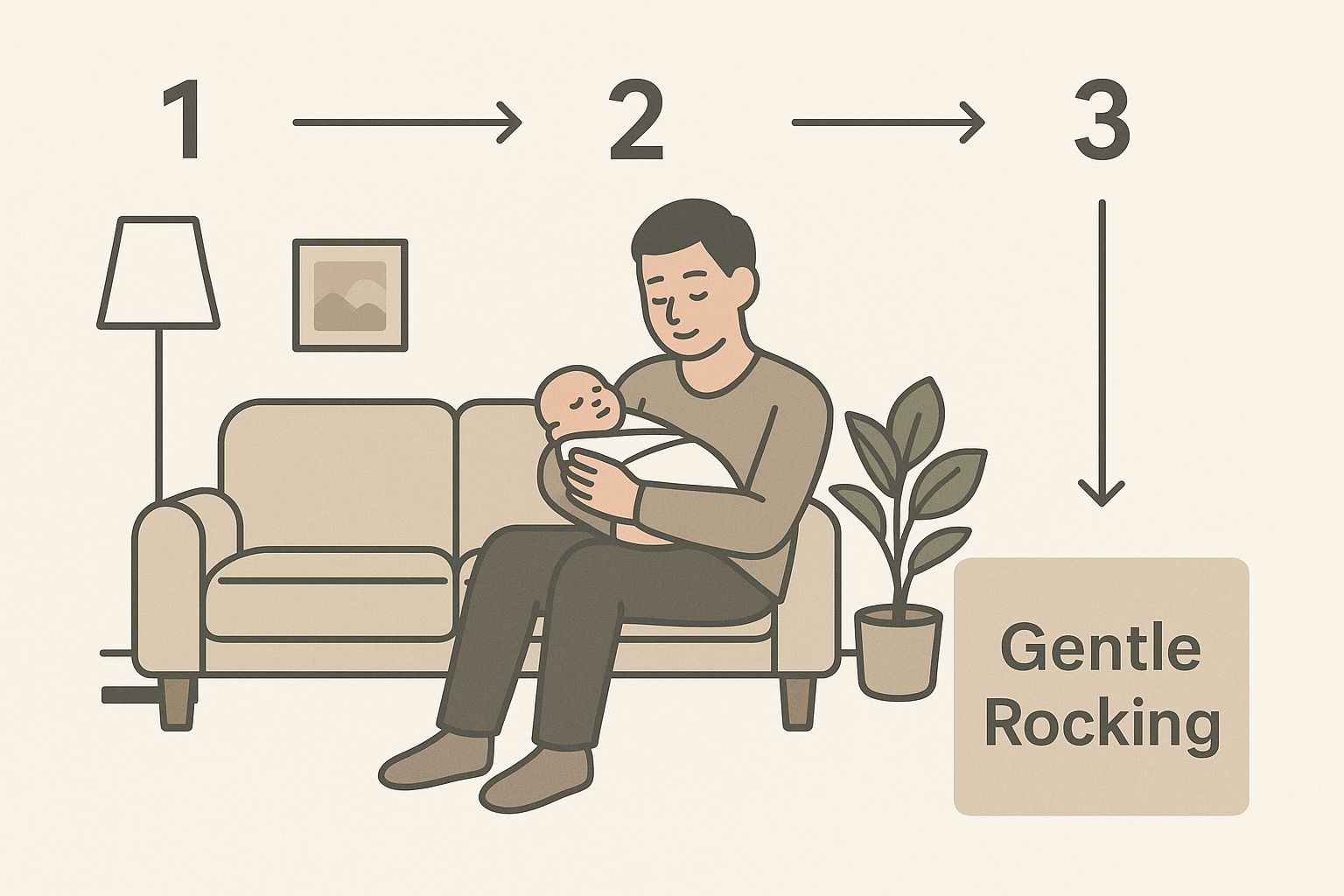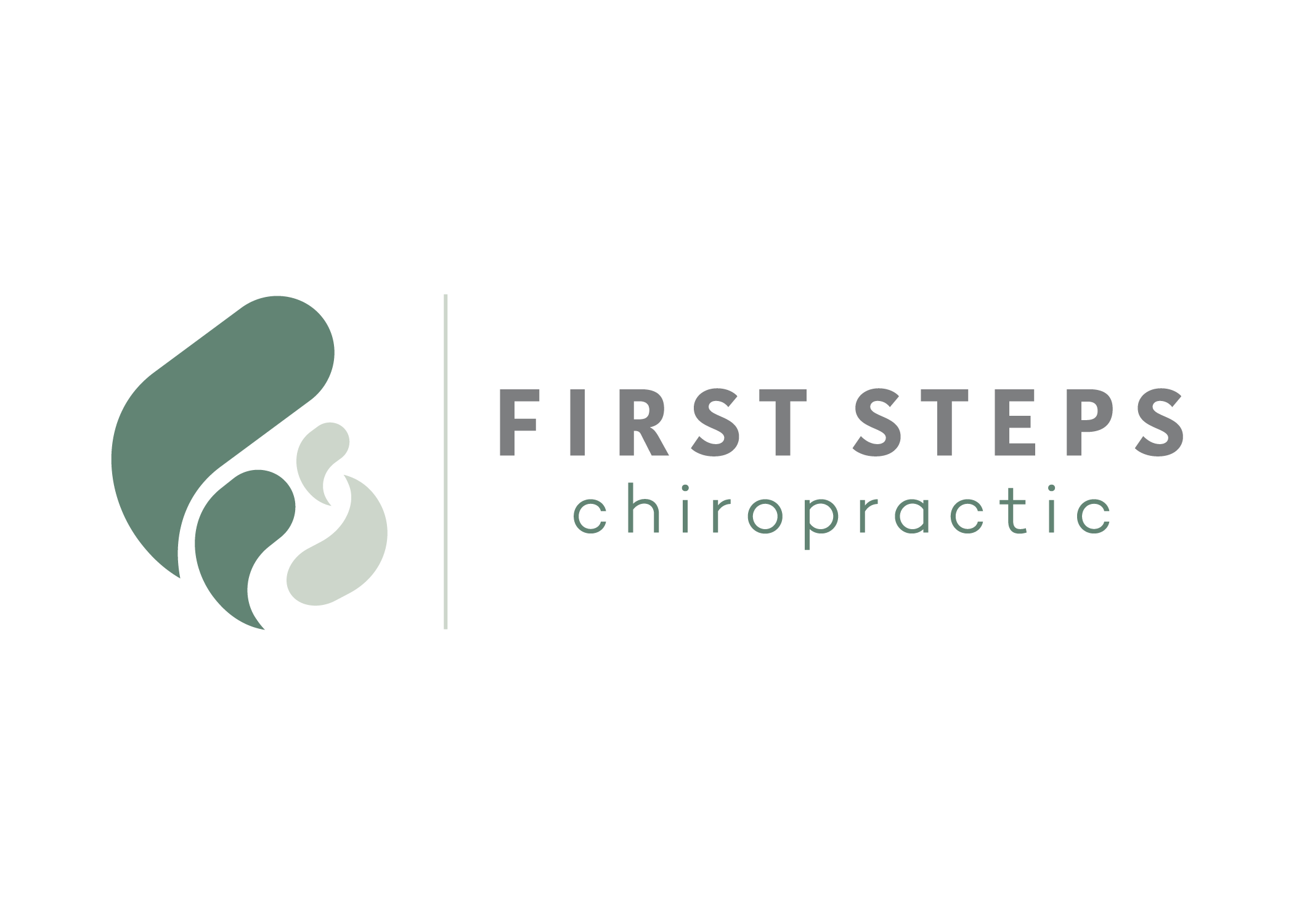When you’re in the thick of it, trying every trick in the book to soothe a crying newborn, finding effective colic relief can feel like searching for a miracle. Colic isn't a disease or a sign that you're doing something wrong. It's a specific pattern of intense, prolonged crying in a baby who is otherwise perfectly healthy.
For exhausted parents, just understanding the signs is the first real step toward finding what works for your little one.
Decoding the Cries: What Is Newborn Colic?

That helpless feeling that washes over you when your baby is crying inconsolably is something countless parents know all too well. It’s stressful, isolating, and can make you question everything. But having some perspective on colic itself can be a game-changer. It’s more than just normal baby fussiness; it's a distinct pattern of distress that can leave even the most seasoned parents feeling overwhelmed.
The classic definition, often called the "rule of threes," is what separates colic from typical crying. A baby is generally considered colicky if they cry for more than three hours a day, for more than three days a week, and this pattern continues for more than three weeks.
While the exact cause is still a bit of a mystery, most theories point to an immature digestive system, painful gas, or sensory overstimulation.
Identifying Colic Beyond the Crying
The crying is impossible to miss, but there are physical cues that often come along with it. Watching for these signs can help you confirm that you’re dealing with colic and not something else.
- Predictable Timing: Does it feel like clockwork? Colic episodes often fire up around the same time each day, usually in the late afternoon or evening.
- Intense Crying: These aren't just whimpers. Colic cries are often high-pitched and frantic, sounding more like your baby is in pain.
- Physical Tension: A colicky baby’s body language says it all. Look for clenched fists, a hard or tight little tummy, and legs pulled up toward their chest.
- Difficult to Soothe: This is the big one. Unlike normal fussiness, these crying spells don't stop with a diaper change, a feeding, or a cuddle. Your baby seems completely inconsolable.
Colic is a common and temporary condition. It’s incredibly challenging, no doubt. But remembering that it has an endpoint provides a vital glimmer of hope during those long, difficult evenings.
The Colic Timeline
If you're in the middle of it right now, you are far from alone. Colic affects nearly 1 in 5 infants worldwide and usually makes its appearance within the first few weeks of life.
The crying often gets worse and peaks around six weeks old. The good news? It typically resolves on its own by three or four months of age. You can learn more about these infant health trends and find detailed insights about colic.
Understanding this timeline helps frame the experience—not as a permanent problem, but as a temporary (albeit very difficult) phase of development.
Soothing Techniques That Actually Work
When your baby is deep in the throes of a colic episode, you need more than just a “wait it out” approach. You need practical, effective colic relief right now. The idea is to build a toolkit of calming strategies that tap into your baby’s fundamental need for security and comfort, which helps to reset their overwhelmed little nervous system.
A lot of parents I work with have found incredible success using a layered approach, often called the “Five S’s.” These techniques are designed to work together to recreate the snug, soothing environment of the womb. For a distressed newborn, this can feel like coming home.
Mastering the Five S’s for Colic Relief
Think of these as building blocks. Sometimes, for simple fussiness, you might only need one or two. But for a full-blown colic meltdown, you’ll likely need to stack all five to trigger your baby’s powerful, built-in calming reflex.
-
Swaddling: This is your foundation. A good, snug swaddle contains that jerky startle reflex that can wake a baby up. It also provides a deep, reassuring pressure that feels like a constant hug. Just make sure it’s a hip-healthy swaddle, leaving plenty of room for their legs to bend up and out in that natural frog-like position.
-
Side/Stomach Position: While you’re holding your baby, try positioning them on their side or stomach across your lap or forearm. This posture can give their digestive system a little help and just feels more secure for them. And this is a big one: this position is only for calming while they are awake and you are holding them. Always, always place your baby on their back for sleep.
-
Shushing: The womb isn't quiet—it’s actually pretty loud. A strong, rhythmic "shhhh" sound, made close to your baby's ear, does a great job of mimicking that constant whooshing they’re used to. You can also use a white noise machine or an app; don't be afraid to turn it up loud enough to match the intensity of their crying.
-
Swinging: Newborns spent nine months in constant motion. Rhythmic, gentle movement is deeply soothing for them. This doesn’t have to be a big, dramatic swing; often, a small, jiggly motion while holding them or a smooth glide in a rocking chair is all it takes.
-
Sucking: Sucking is one of a baby’s most powerful tools for self-soothing. Offering a pacifier, your clean finger, or the breast can provide almost instant comfort. It helps them organize those big, distressing feelings.
A common mistake I see is parents trying each technique for just a few seconds before giving up. You have to commit. Try each "S" for a few minutes before adding the next one. It’s the combination of these layers that often creates the magic, offering powerful relief when they need it most.
Additional Comforting Strategies
Beyond the Five S's, a few other methods can bring significant comfort.
Skin-to-skin contact is incredibly powerful. Simply placing your baby, in just their diaper, directly onto your bare chest helps regulate their heart rate, breathing, and temperature. It’s a biological reset button.
Gentle baby massage is another fantastic tool. Using a food-grade oil, make slow, clockwise circles on their tummy to help encourage trapped gas to move along. Gently bicycling their legs can also help relieve that uncomfortable pressure.
While we often focus on the intense crying, it's important to remember that some babies are also struggling with underlying issues like reflux. For a deeper dive, you can explore our guide on the connection between colic and reflux.
And finally, never underestimate the power of a warm bath. The gentle immersion can relax tense little muscles and provides a wonderful distraction from their discomfort. If you can create a calm, dimly lit environment for the bath, it can become a truly tranquil experience for both of you.
Rethinking Feeding to Reduce Discomfort
Sometimes, the simplest path to colic relief isn’t a new soothing technique, but a closer look at your baby’s feeding routine. Making small, intentional adjustments can make a massive difference in how much air your baby swallows—a major culprit behind that painful gas and fussiness. Whether you're breastfeeding or bottle-feeding, rethinking how your baby eats can change everything.
For babies on the bottle, the name of the game is slowing things down. It's so common for little ones to gulp their milk too quickly, taking in a ton of air along with it. This is where paced bottle feeding comes in. Instead of tipping the bottle up and letting gravity do the work, hold it horizontally. This lets your baby actively work for the milk, just like they would at the breast, and take natural pauses when they need to.
Choosing the Right Tools for Bottle Feeding
The bottle itself can be a huge help. Anti-colic bottles are specifically designed with vents or internal systems to keep air from mixing with the milk. Less air in the bottle means less air in your baby’s tummy. Simple as that.
This kind of thoughtful bottle design has become a go-to for parents struggling with a colicky baby. It's a massive market for a reason—the global anti-colic baby bottle market was valued at about $2.5 billion in 2025 and is expected to climb to $4.2 billion by 2033. This surge just goes to show how many families rely on these tools, especially when their babies are in that 0-6 month window where colic peaks. You can dive deeper into the data by checking out the anti-colic bottle market trends on datainsightsmarket.com.
With so many options out there, from vented nipples to internal straw-like systems, picking the right one can feel overwhelming. Let’s break down the most common features.
Comparing Anti-Colic Bottle Features
| Feature Type | How It Reduces Air Ingestion | Best For Babies Who… |
|---|---|---|
| Vented Nipples | Small vents on the nipple itself open to let air in as the baby drinks, preventing a vacuum from forming. | Are generally good eaters but swallow some air. A good starting point for most families. |
| Internal Vent Systems | A tube or straw-like insert channels air from the nipple to the bottom of the bottle, keeping it away from the milk. | Gulp their milk quickly or have significant reflux. These offer maximum air reduction. |
| Collapsible Liners | A pre-sterilized liner inside a rigid bottle holder collapses as the baby eats, eliminating air pockets entirely. | Suffer from severe gas and fussiness. Also great for convenience and travel. |
| Angled Bottles | The bent shape helps keep the nipple full of milk even when the bottle is held at a more horizontal angle. | Tend to be fed in a more upright position to help with reflux. |
Ultimately, you might have to try a couple of different types to see what clicks for your little one. Every baby is different, and their preferences can be surprisingly strong!
Adjustments for Breastfed Babies
If you're breastfeeding, you might face a different set of challenges. A poor latch is one of the most common reasons a breastfed baby swallows too much air. Getting a deep, effective latch is the first and most important step. If you're struggling, a lactation consultant can be your best friend, helping you make tiny tweaks that create a good seal.
Another common issue is a forceful letdown, where your milk flows so fast it overwhelms your baby, causing them to gulp and sputter. If you think this might be happening, here are a couple of things to try:
- Lean back: Nursing in a reclined position uses gravity to your advantage, slowing down the flow.
- Express a little first: Hand express or pump for just a minute before you latch your baby. This helps get past that initial, powerful surge.
In some situations, a baby might be sensitive to something in your diet. Dairy is a common suspect, but it could be other things, too. It's really important to talk with your pediatrician before you start eliminating entire food groups. They can guide you on how to do it safely so both you and your baby continue to get the nutrients you need.
Remember, the goal isn’t to find a single “magic” fix. It's about observing your baby and making small, iterative changes to their feeding experience to see what brings them the most comfort.
The Importance of a Good Burp
No matter how you feed your baby, a good, thorough burp is non-negotiable. Those trapped gas bubbles can be incredibly painful. Don't just stick to one position—if gentle pats on the back aren't working, switch it up. Try laying your baby tummy-down across your lap or sitting them up while supporting their chin and chest. Sometimes a change in position is all it takes to release a stubborn air bubble.

The gentle motion you see here isn't just for calming a fussy baby; it can also help dislodge those trapped gas bubbles, making your burping efforts much more effective and giving your newborn some much-needed colic relief.
Gentle Chiropractic Care: A Calming Option

So, you’ve tried all the swaying, shushing, and swaddling. You've changed feeding routines, and your little one is still struggling. When you’re at your wit's end, it’s natural to start looking for gentle, non-invasive options. This is where many parents find themselves considering pediatric chiropractic care as a potential source of relief.
It’s an approach focused on your baby’s overall comfort and the proper function of their nervous system.
I know what you might be thinking—chiropractic for a baby? It can sound a little intimidating. But let me reassure you, neonatal adjustments are a world away from what adults experience. The pressure we use is incredibly light.
Think about the amount of pressure you’d use to check if a tomato is ripe. That’s it. It’s all about gentle, sustained contacts, not forceful movements.
The core idea here is that the birthing process—whether it’s fast and furious or long and difficult—can be a physically stressful event for a newborn. That stress can sometimes lead to tiny misalignments in their spine, especially in the upper neck. We call these misalignments "subluxations," and they can interfere with the nervous system's ability to communicate properly, which can affect everything from digestion to overall comfort.
What A First Visit Looks Like
When you bring your baby in, the first thing we do is talk. I want to hear the whole story—from pregnancy and birth to their current symptoms. It’s a calm, gentle experience. After our chat, I’ll do a careful examination, using just my fingertips to feel for areas of tension and restricted movement in your baby’s spine and cranium.
The actual adjustments are very subtle. I might use a light fingertip pressure on a specific spot on their back or neck, or gently cradle your baby’s head to help release tension. Many babies are so relaxed they sleep right through it.
The goal isn't just to "fix" one problem. It's about supporting your baby's entire system. By improving how the nervous system functions, we often see a positive ripple effect on their digestive comfort, which can lead to a much calmer, happier baby.
A Complementary Approach To Wellness
It's really important to see pediatric chiropractic care as a complementary therapy, not a cure-all. It works right alongside the excellent care you’re getting from your pediatrician to support your baby’s overall well-being. So many parents tell me that after a few sessions, their baby seems more relaxed, passes gas more easily, and those intense crying spells start to fade.
If you’d like to dig a little deeper, you can learn more about the transformative power of chiropractic care for newborns and how it fits into your family’s wellness journey. The approach is simple: improve function so your baby's body can better adapt, regulate, and thrive.
Ultimately, chiropractic care offers a gentle way to address underlying physical tension that might be contributing to your baby's discomfort. By focusing on the root of the issue—the nervous system—it provides a supportive therapy that many families find is a valuable piece of their colic relief puzzle.
Knowing When to Call Your Pediatrician
While most cases of endless crying do turn out to be colic, it's absolutely essential to know when those cries might be signaling something more serious. Part of being a confident advocate for your baby is trusting your gut and knowing how to tell the difference between typical colic and a situation that needs a doctor's immediate attention. Remember, your pediatrician is your partner on this journey.
It's easy to get overwhelmed in the pharmacy aisle, surrounded by products promising colic relief. Things like gas drops (simethicone) and gripe water are common over-the-counter options many parents reach for. But it’s always best practice to chat with your pediatrician before giving your newborn anything new. Effectiveness can vary wildly, and some ingredients just aren't suitable for every baby.
The market for these products is massive for a reason. The global baby toiletries industry, which includes these colic aids, was valued at around USD 113.33 billion in 2024. That number alone shows just how many parents are out there, just like you, searching for ways to bring their little ones comfort.
Understanding the Red Flags
True colic, frustrating as it is, doesn't come with other signs of illness. If your baby's intense crying is paired with any of the following symptoms, it’s a clear signal to call your pediatrician right away. Think of this as your safety checklist.
- Fever: Any rectal temperature of 100.4°F (38°C) or higher in a newborn is a medical emergency. Don't wait.
- Vomiting: We're not talking about a little spit-up here. Forceful, projectile vomiting or any vomit that looks green or yellow needs an immediate call to the doctor.
- Changes in Stool: Be on the lookout for blood in the stool, diarrhea, or constipation that seems to be causing real pain.
- Poor Feeding or Weight Gain: If your baby is suddenly refusing to eat, seems unusually tired and lethargic, or isn't gaining weight as expected, it's time for a check-up.
- Behavioral Shifts: A baby who is unusually sleepy, floppy, or very difficult to wake is a major cause for concern.
Trust your gut. You know your baby better than anyone. If something just feels off, or if the crying suddenly changes in tone or intensity, making that call to your doctor is always the right choice. It will give you peace of mind and ensure your baby gets the exact care they need.
Another topic worth bringing up with your doctor is probiotics. Some research suggests certain strains might help balance a baby's gut microbiome and reduce crying time, but this is far from a one-size-fits-all solution and requires professional guidance.
It's also important to remember that other physical issues can sometimes mimic colic symptoms. For instance, an undiagnosed tongue tie can interfere with feeding, causing a baby to swallow a lot of air and become extremely fussy. It’s crucial to rule out possibilities like this, and you can learn more by navigating the challenges of tongue ties in newborns in our detailed guide. Always work with your pediatrician to rule out underlying medical issues before settling on a colic diagnosis.
Common Questions About Newborn Colic
Even after trying every soothing trick in the book, navigating the world of newborn colic can leave you with a lot of questions. It's completely normal to feel like you’re still searching for answers. Let’s tackle some of the most common concerns parents bring to us, giving you direct, reassuring information to get you through this phase with more confidence.
Many parents wonder if they’re in it for the long haul. The good news? Colic is a temporary, though definitely challenging, stage in your baby’s development.
How Long Does Colic Typically Last?
For most little ones, this intense period of crying follows a pretty predictable pattern. It often kicks in within the first few weeks of life, hits its peak around six weeks of age, and then starts to improve. You can typically expect the crying spells to resolve on their own by the time your baby is three to four months old.
I know it feels endless in the moment, but just knowing there’s a finish line can be a huge comfort. Of course, if the intense crying continues well beyond this timeframe or you notice other worrying symptoms, it's always the right call to check in with your pediatrician.
Could My Diet Cause Colic if I'm Breastfeeding?
This is a great question and something many nursing moms consider. It is possible for some babies to be sensitive to proteins from foods in their mother's diet, which can pass through the breast milk. Dairy is a common suspect, but other foods can sometimes be the culprit.
Before making any drastic dietary changes on your own, it's best to chat with your doctor or a lactation consultant. They can help you systematically and safely pinpoint potential triggers without compromising your own nutrition.
Is Chiropractic Care Actually Safe for My Newborn?
Absolutely. When performed by a licensed chiropractor who has specialized pediatric training, gentle adjustments are considered very safe. The techniques we use on infants are incredibly light and involve no forceful movements—often it’s just a sustained pressure no heavier than what you’d use to test the ripeness of a tomato.
The goal is to ease underlying tension in their little bodies that may be contributing to discomfort. Always choose a certified practitioner and discuss this option with your pediatrician to make sure it's a good fit for your baby’s specific needs.
How Is Colic Different From Reflux?
While both can cause a whole lot of fussiness, their key symptoms are different. Colic is really defined by that unexplained, inconsolable crying that tends to follow a predictable daily pattern, often in the evenings.
Reflux, or gastroesophageal reflux (GER), on the other hand, involves stomach contents coming back up into the esophagus. This usually leads to frequent, painful spitting up, arching the back during or after feeds, and general discomfort related to eating. If you're noticing these specific signs, a visit to the doctor is definitely needed to get an accurate diagnosis.
At First Steps Chiropractic, we understand the deep stress that comes with having a colicky baby. Our gentle, neurologically-focused approach is designed to support your infant’s overall comfort and well-being. Schedule a complimentary consultation today to learn how we can help your family find peace and relief.

